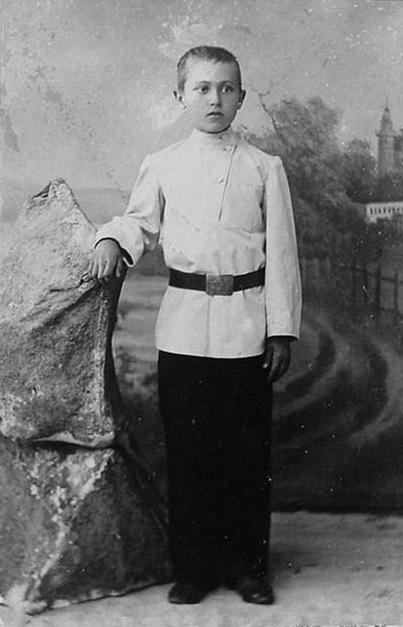
Tsarist Russian Schools: Types

Figure 1.--This unidentified Russian boy was photographed in his school uniform, we think in the late-19th century. The portrait is a CDV taken by M.A. Kucherinova. The boy looks to be a new student in a Ministry of Education secondary school because the uniform is fairly basic. We think the Ministry of Defense schools would have had uniforms with more elaborate military features.
|
|
There were many different types of schools in Tsarist Russia. The system was somewhat complicated. They can be best grouped as to who finznced them. The term public does not capture the idea used in the West where the government provided tuition free schools for the bulk of the population. The Tsarist state financed only a portion of the country's schools and we are not sure at this time just how large that portion was. Nor do we know if state funds were used for some of the non-state administered schools in Russia. The other schools were 2) religious, 3) self-rule units, and 4) private schools. The Ministry of Education established a variety of regulations and thus exercised a degree of control over the curriculum and other matters. An important aspect of educatiin t these schools, in a multi-national empire was the language of instruction.
State Agencies
Russia was not much affected by the movement toward public schools that began in Western Europe, especially in the German states (18th century). A factor here was the Reformation which affected the Baltics. Poland, but not further east into Russia. A factor here is that these areas were acquired by Tsarist Russia afdter the Reformstion had already affected relgious prctices. We are not sure at this time when the Tsarist state began funding state primary and secondary schools. Surely emancipation of the Serfs (1861) was a major milestone. Until that education in rural Russiawas very limited. After emancipation, primary education becgins to become available to the former serfs. Educational oportunity, however, cntinued to be limited, compared to Western Europe. Very few Russian children were able to advance to secodary schools. This was primarily limited to the middle class in the cities. We have few details at this time on Government education policy. At the time of the Revolution (1917), large numbers of Russians, especially in rural areas, were still iliterate. There were two different types of state schools, includung schools administered by the Ministry of Education and the Ministry of Defence. State schools were taught in the Russian language. Latin, Greek, French and German were taught as foreign lsnguages.
Religious Groups
Several religious groups opeated schools in Russia. The Orthodox Church played a major role in Russian education. But neiter the Orthodox Church or the large landowners showed much interest in educating the huge rural serf population. In fact a substantial part pf the Orthodox clergy was itself functionslly iliterate. The Church's involvement in education chnged over time. Both the Orthodox and Catholic churches operated schools. The most importyant church wasthe Orthodox Church, wespecially in the Russian heartland. The Catholic Church was important regionally, especially in the western Ukraine, Poland, and the Baltics. There were also Muslim and Jewish schools. The Muslim schools were commonly called Tartar schools at the time. We are not sure if the state provided partial funding for these schools. Church schools were taught in Russian or local languages. Schools in Russia primrily used used Russian and Ancient Slavic as the primary laguages. Latin and Greek were tught as foreign languges. Some Ctholic churches were taught in languges like Polish and Lithuanian. I am not sure about Urkranian. Here language policies changed over time. Arabic might be used in the Muslim schools. Hebrew was used in Jewish schools. I am not sure about Yidish. Jewish schools were only permitted inside the Pale of Settlement. Outside of that area (and in cities Kiev, Nikolaev, Yalta and Sevastopol that geographicaly were in the Pale of Settlement but excluded from the Pale) jewish settlements and schools were forbidden.
Self-rule Units
There were a variety of self-rule units in Tsarist Russia. They includedf Volost, U'ezd, and towns, many of which supported schools. Here both local languages and Russian was used. Again we do not know if any state funding was available. An example is the 1st Rotgof Volost Secondary School. Rotgof is a district near the city of Ventspils in modern Lithuania. At the time part of the Tsarist Empire. Volost was a small unit of peasant's self-rule.
Private
We are not sure about the importance of private schools in Tsarist Russia. We know they existed, but we are not sure about the numbers and relstive importance. Private schools had a choice as to language. Often both a local langauge and Russian was used for instruction.
HBC

Related Chronolgy Pages in the Boys' Historical Web Site
[Main Chronology Page]
[The 1900s]
[The 1910s]
[The 1920s]
[The 1930s]
[The 1940s]
[The 1950s]
[The 1960s]
[The 1970s]
Navigate the Relate Boys Historical Clothing Style Pages
[Return to the Main country page]
[Return to the Main Russian page]
[Long pants suits]
[Short pants suits]
[Lederhosen]
[Kneesocks]
[Eton suits]
[Jacket and trousers]
[Blazer
[School sandals]
Navigate the Boys' Historical Clothing School Uniform Pages
[Return to the Main Russian Tsarist school page]
[Return to the Main Russian school page]
[Return to the Main School Uniform Page]
[Return to the Main National School Uniform Page]
[Australia]
[England]
[France]
[Germany]
[Ireland]
[Italy]
[Japan]
[New Zealand]
[The Philippines]
[Poland]
[Scotland]
[South Africa]
[United States]
Navigate the Boys' Historical Clothing Web Page
[Introduction]
[Activities]
[Biographies]
[Chronology]
[Clothing styles]
[Activities]
[Bibliographies]
[Contributions]
[FAQs]
[Glossaries]
[Images]
[Registration]
[Tools]
[Boys' Clothing Home]
Created: 4:56 AM 9/18/2011
Last updated: 4:56 AM 9/18/2011




